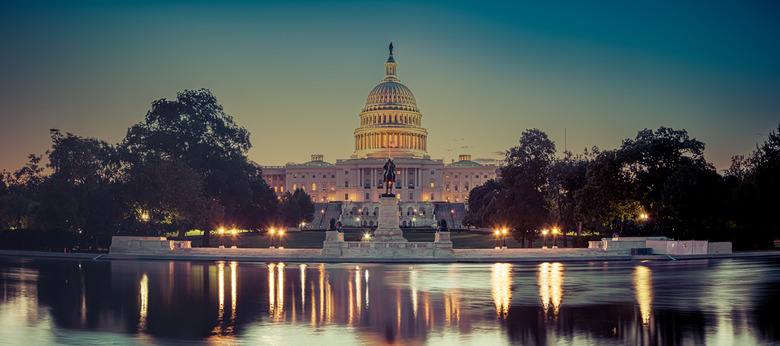List Of Natural Resources In Washington, D.C.
America's capitol city, Washington D.C., is a place of unparalleled scenic beauty, historic value and natural resources. Three bodies of water flow through and around the city, the Potomac River and its branches, the Anacostia River and Rock Creek. Urban development has changed the city's landscape, but federal preservation efforts restored areas into parks and gardens. The rich wetlands offer residents and visitors a one-of-a-kind environmental view into the city's past.
Rock Creek Park
Located in northwest Washington, D.C., Rock Creek Park is one of the oldest national parks. With 1,755 acres, it is more than twice as large as New York Central Park. Founded in 1890, the park protects the area's ancient beauty. Many artifacts found in the park date from 2500 B.C. The park contains the only surviving water-powered grist mill on the Potomac, the Peirce Mill, and two Civil War forts, Stevens and DeRussy. A nature center and planetarium offers walks, hike and bike trails and tours through the region to view the lush native vegetation and animal life.
The U.S. National Arboretum
Created in 1927, the 446 acres is a research facility and living museum managed by the Department of Agriculture. It promotes the area's native plants and wildlife through scientific, educational programs and gardens. The plant and tree species include azalea, boxwood and daffodil, lily, dogwood, and magnolia, maple and peony. The gardens offer a diverse collection that features aquatic plants, the Asian collection and the Fern Valley native plants, and the national herb garden. Visitors can stroll through the flowering tree walk and the national grove of state trees. Two additional research facilities are located in Beltsville, Maryland, and McMinnville, Tennessee.
Chesapeake and Ohio Canal National Historical Park
The "Grand Old Ditch" also called the "C&O Canal" began in 1828. Intended to reach to Pittsburgh, it only extended 185 miles to Cumberland when completed in 1850. The railroad made it obsolete so the canal only transported coal by towpaths into the city until 1924. The National Park Service restored the canal in 1938 into recreational areas that preserved the site's natural beauty. Bikers and hikers enjoy trails along the Potomac River Valley. Mule-driven boats tow visitors along the renewed canal.
Kenilworth Park and Aquatic Gardens
The only remaining tidal wetland in D.C., the 700-acre Kenilworth Park & Aquatic Gardens is home to rare plants and multiple wildlife species. Fed by the Anacostia River, the garden started in the 1880s by a Civil War veteran, Walter B. Shaw, who imported water lilies from his native Maine. The U.S. government bought it in 1938. Lotus and water lilies from around the world fill the marsh ponds. Loons, great blue herons and five kinds of frogs, two species of toads, and four species of turtles, three species of non-poisonous and nine species of mammals are among the many species that reside in the marsh and garden.
Cite This Article
MLA
Valdez, Valerie. "List Of Natural Resources In Washington, D.C." sciencing.com, https://www.sciencing.com/list-natural-resources-washington-dc-6826937/. 22 November 2019.
APA
Valdez, Valerie. (2019, November 22). List Of Natural Resources In Washington, D.C.. sciencing.com. Retrieved from https://www.sciencing.com/list-natural-resources-washington-dc-6826937/
Chicago
Valdez, Valerie. List Of Natural Resources In Washington, D.C. last modified March 24, 2022. https://www.sciencing.com/list-natural-resources-washington-dc-6826937/
